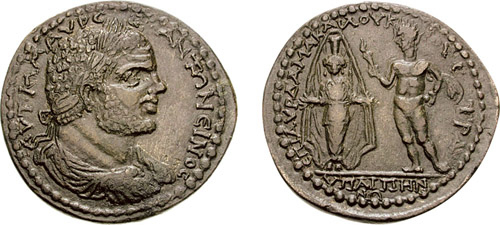Lorem ipsum dolor sit amet, consectetur adipiscing elit. Morbi eu nulla vehicula, sagittis tortor id, fermentum nunc. Donec gravida mi a condimentum rutrum. Praesent aliquet pellentesque nisi.


Artemis Anaitis at Philadelphia, Lydia
Lydia, Philadelphia, Faustina II, under Archon Ladik. Severus, 161-9 AD, AE 28, 16.30g, 7h.
FAVCTEINA – CEB – ACTH (beginning upper r.), bust draped r.
EPI LADIK(?) CEBHPOV – APX F[ILAD]ELFEWN (beginning upper r.), turreted city goddess standing r., head l., holding patera and statuette of Artemis Anaitis.
SNG Munich 424 (same obv. die, different rev. die). RPC temp. 9346 knows only this Munich specimen, ex Cousinéry Collection, the identical specimen described by Mionnet 4, no. 574. Date 161-9 because coins were struck with double portraits of Marcus Aurelius and L. Verus under the same magistrate, RPC temp. 1359.
Mionnet describes the cult statue held by the city goddess as being Artemis of Ephesus, and this description was repeated in SNG Munich 424 and RPC temp. 9346. On my new coin, however, she appears to be Artemis Anaitis instead, who looks quite like the Ephesian Artemis, but has a tall kalathos on her head, supporting a veil which falls all the way to the ground on both sides of her body, as on the coin of Caracalla at Hypaepa also shown below. This seems to be the only depicition of Artemis Anaitis on a coin of Philadelphia, but her appearance at Philadelphia is not surprising, since Philadelphia is not far from Hypaepa, the center of the cult of Artemis Anaitis in Asia Minor.
An interesting divinity, according to BMC Lydia, pp. lix f.: “From the few notices of Hypaepa in ancient writers and from the inscriptions…, we learn that the inhabitants were known as ‘Persian Lydians’, and that the veiled goddess whose effigy appears on the coins represents the Persian Anaitis, whose worship is described by Pausanias (v. 27, 5) as consisting of a ritual chanted from a book by priests wearing the tiara, in a language unintelligible to the Greeks. The celebration included the miraculous kindling of fire upon the altar of the goddess.”